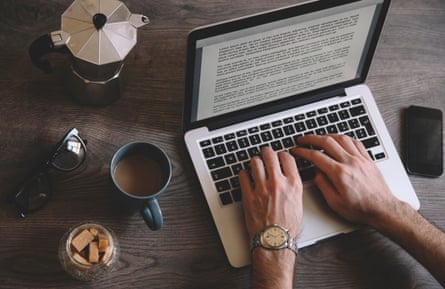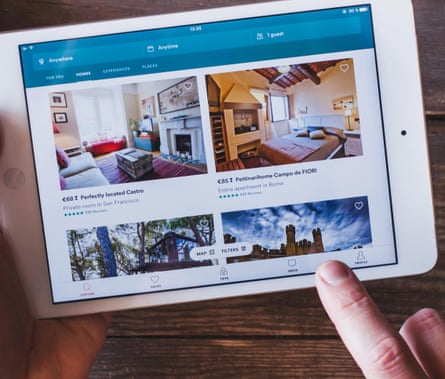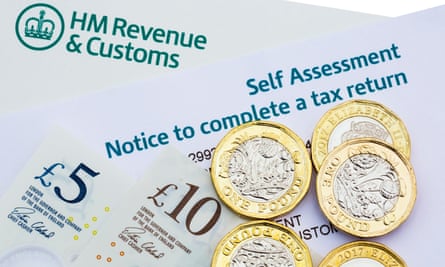If you are among the 12.2 million people required to file a self-assessment tax return but are yet to complete it, you’d better get your skates on as there is just over a fortnight to go until the midnight on 31 January deadline.
For the last two years, HMRC has waived the £100 late-filing penalty but those yet to file shouldn’t bank on the same level of goodwill this year, the accountancy firm BDO is warning.
Fail to file for a further three months and you will incur additional daily penalties of £10 – up to a maximum of £900. As well as penalties for filing late, HMRC can fine taxpayers for up to 30% of the tax due for careless inaccuracies.
If you are one of those who has been putting it off, here’s the last-minute Guardian Money guide to getting it right.
Don’t forget to claim working from home tax relief
Employees can still claim £6 a week (£312 for the year) working from home relief without having to justify the figure. It doesn’t matter if you only worked part of the week at home. The only requirement is that your employer demanded it.
This relief can only be claimed where the employer did not reimburse expenses. Those completing a self-assessment tax return can simply claim £312 as an expense on the “employment” pages. Those not within self-assessment should apply for relief online via HMRC’s website, says the tax expert RSM.
 View image in fullscreenAre you entitled to claim tax relief for working from home? Photograph: lechatnoir/Getty Images
View image in fullscreenAre you entitled to claim tax relief for working from home? Photograph: lechatnoir/Getty Images
Don’t miss out on pension tax relief
For many people this is a key area of confusion but If you are entitled to make a claim and don’t, it could cost you hundreds or even thousands of pounds.
The way it works depends on what scheme you are in. “Net pay” arrangements are used by many traditional workplace pension schemes and don’t require you to do anything to get tax relief. With these, your pension contributions are deducted from your salary by your employer before income tax is calculated, so you get relief on the amount immediately at your highest rate of tax.
However, the rules are different if you are in a “relief at source” arrangement – used by personal pension plans as well as some workplace schemes. If you are a 20% taxpayer, then don’t worry – no further adjustment needs to be made. But higher-rate taxpayers must make a claim via their tax return to receive the extra relief due to them.
 View image in fullscreenYou may have to pay the high income child benefit charge if you or your partner earn more than £50,000 and get the benefit. Photograph: Ian Jones/Alamy
View image in fullscreenYou may have to pay the high income child benefit charge if you or your partner earn more than £50,000 and get the benefit. Photograph: Ian Jones/Alamy
If you are not sure which kind of scheme you are in, ask your HR department or whoever does the payroll for your employer.
You need to declare it if you earn £50,000 and the family receives child benefit
Large numbers of families have been pulled into the self-assessment regime because at least one parent has an income of more than £50,000. Under the government’s high income child benefit charge, the child benefit is clawed back via the tax system on a sliding scale.
BDO says that if you were previously paying the charge but your income dropped during the 2021–22 tax year as a result of being furloughed, you may have paid too much tax through your pay, so check if you are due a refund. “And think about earlier years, too: if you did not spot this issue in 2020-21 or earlier, contact HMRC directly to get it put right,” it says.
It may be too late for this year but there are ways you can legitimately reduce the tax hit and, in some cases, escape the charge completely. The main one is by paying more into your pension (if you can afford it). Contributions made into a company or personal pension scheme will reduce your “adjusted net income” (your total taxable income, minus things such as pension contributions), which is what the tax charge is based on. For example, you could pay additional voluntary contributions into an occupational scheme.
Claim tax relief for other job expenses
If you are an employee and have to pay fees or annual subscriptions to one or more professional bodies to carry out your job, you can claim tax relief. Put the fees in box 19 on the employment page. There is a list of approved professional organisations, such as the Law Society, and lots of others.
Claim gift aid at the higher rate
Donating through gift aid means charities can claim an extra 25p for every £1 you give. It won’t cost you any extra. If you are a higher-rate taxpayer, you can claim the difference via your tax return. For example, if you donate £100 to a charity and gift aid is used, it makes your donation £125. You pay 40% tax, so you can personally claim back £25 (20% of £125).
Use the trading allowance for any extra self-employed expenses
You can claim a flat £1,000 for self-employed expenses using the trading allowance – without needing to keep business receipts. The alternative is that you can claim every single business expense if your expenses exceed £1,000 annually. If this is the case, you will need to keep all your receipts (or bank statements can also work) – it’s important to note that you can’t do both.
 View image in fullscreenDo you have additional income from renting out property on Airbnb or similar? Photograph: Anna Berkut/Alamy
View image in fullscreenDo you have additional income from renting out property on Airbnb or similar? Photograph: Anna Berkut/Alamy
Don’t forget about or leave out additional income
You can check whether you need to declare, or possibly pay tax on, any casual income you receive. HMRC says its new interactive tool – explains what, if anything, individuals need to do if they receive non-PAYE income from – for example – selling items online, doing casual jobs or renting out property on Airbnb or similar. The good news is that you get a £1,000-a-year tax-free allowance for property income and trading income (if you have both, you will get a £1,000 allowance for each).
Don’t forget Covid support payments
All payments received under coronavirus support schemes are taxable, and therefore need to be declared. While the scheme finished at the end of September 2021, individuals might have received support payments in the period 6 April 2021 to 31 September 2021 that should be reported on their tax returns.
Married? For some it will mean a lower tax bill
The marriage allowance (page TR5) is a tax break that lets someone whose income for the year ending 5 April 2022 was less than £12,570 transfer £1,260 of their personal allowance to their husband, wife or civil partner. This reduces the recipient’s tax by up to £252 a year currently.
The couple must be married or in a civil partnership; they were both born after 6 April 1935; and the would-be recipient’s income was not taxed at the higher rate. To find out more, go to gov.uk/marriage-allowance.
Check out the new HMRC app
 View image in fullscreenHMRC has options for those struggling financially. Photograph: Realimage/Alamy
View image in fullscreenHMRC has options for those struggling financially. Photograph: Realimage/Alamy
HMRC’s new app doesn’t yet allow you to file a tax return but it does allow you to access a lot of key information including your tax code, national insurance number, income history going back five previous years, and your current self-assessment balance. It also allows you to claim a refund if you have paid too much tax.
If you cannot afford your tax bill, there are options
If your tax bill is unaffordable don’t panic. HMRC has options for those in financial distress, so burying your head in the sand and racking up fines is not the answer, says Bestinvest. The Time to Pay scheme is a payment plan for those that owe less than £30,000, are within 60 days of the payment deadline and plan to clear the debt within 12 months, it says.



